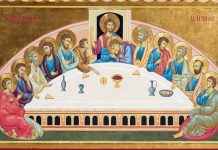
Using objects, stories, songs, or even jokes
JARED DEES
 St. Patrick’s most famous teaching tool was the shamrock. According to legend, he used the three-leafed clover as a metaphor for the Trinity: three persons (three leaves), one God (one clover). The metaphor was a great way to grab attention, and it made it much easier to understand the idea of God as a Trinity.
St. Patrick’s most famous teaching tool was the shamrock. According to legend, he used the three-leafed clover as a metaphor for the Trinity: three persons (three leaves), one God (one clover). The metaphor was a great way to grab attention, and it made it much easier to understand the idea of God as a Trinity.
Inspired by his example, we can strive as catechists to find metaphors to help us teach about complex doctrines. These metaphors could be objects (such as the shamrock), stories, songs, and even jokes. While your students might forget some of the specific details about what you taught, the metaphor will be much easier for them to remember.
Below are a few ways to find meaningful metaphors to make your lessons more memorable.
Objects
 Bringing in a physical object that students can touch and see throughout the entire lesson is one of the best ways to make your lesson memorable. Even a picture of an object can be a great way to introduce a lesson. You can bring in objects with clear connections to sacraments: water for Baptism, oil for Confirmation, or a wedding ring for Matrimony. If you are reading stories from the Gospel, bring in an object to help make that story more memorable: seeds for parables, cotton balls for sheep, a cross for the crucifixion, a stone for the Resurrection, and so on. You can think more abstractly and look for objects around the house to help make connections to the lesson. For example, I like to use a rubber band to explain the difference between mortal sin and venial sin: venial sin stretches us apart from God like a rubber band stretches, but mortal sin breaks our relationship with God like a rubber band snapping in half.
Bringing in a physical object that students can touch and see throughout the entire lesson is one of the best ways to make your lesson memorable. Even a picture of an object can be a great way to introduce a lesson. You can bring in objects with clear connections to sacraments: water for Baptism, oil for Confirmation, or a wedding ring for Matrimony. If you are reading stories from the Gospel, bring in an object to help make that story more memorable: seeds for parables, cotton balls for sheep, a cross for the crucifixion, a stone for the Resurrection, and so on. You can think more abstractly and look for objects around the house to help make connections to the lesson. For example, I like to use a rubber band to explain the difference between mortal sin and venial sin: venial sin stretches us apart from God like a rubber band stretches, but mortal sin breaks our relationship with God like a rubber band snapping in half.
 A great way to introduce a lesson is to place the object in the front of the room (or hold it before the students) and have the students tell you about what you are holding. Have them give simple descriptions of what the object is to tap into their prior knowledge. This will help you use the metaphor to make the connection. For example, once your students tell you all the ways humans use water (such as taking a bath), the explanation of how Baptism is like a bath for our souls will make a lot more sense.
A great way to introduce a lesson is to place the object in the front of the room (or hold it before the students) and have the students tell you about what you are holding. Have them give simple descriptions of what the object is to tap into their prior knowledge. This will help you use the metaphor to make the connection. For example, once your students tell you all the ways humans use water (such as taking a bath), the explanation of how Baptism is like a bath for our souls will make a lot more sense.
Stories
Beyond physical objects, stories are a great way to introduce a lesson and make it more memorable. You can share conversion stories from your own life. (After all, you are called to be a witness, not just a teacher). You can also share the stories of the lives of the saints or people in the Bible. You can find relevant stories from fiction in books to read or movies to show briefly in class. Humans are wired to remember stories. The more we include them in our lessons, the more memorable the lessons will be.
Songs
Find a song that students might recognize from Mass or play a praise and worship song for
them. You could even bring in music from other genres, but be careful to find material that
is appropriate. Print out the lyrics and have the students make predictions about what the song means. After listening and talking about the lyrics, introduce the lesson of the day and refer back to the song as you go into greater detail about the doctrine. For example, you might play or sing together “One Bread, One Body” to introduce a lesson on the effects of the Eucharist.
Jokes
Finally, jokes can be a quick way to introduce a lesson. Young kids love learning and telling jokes because they are so easy to remember. Find a relevant and appropriate joke or make one up on your own. It doesn’t even have to be funny; it just has to be memorable. Then use that joke as the punch line of the lesson (get it?). In a lesson on St. Peter and the papacy, you might tell this joke: “What is St. Peter’s favorite flavor of ice cream?” Answer: “Rocky Road.” It may not be hilarious, but it will help explain the meaning of Matthew 16:18 when Jesus renames Simon as Peter (a name that means “rock”) and says, “Upon this rock I will build my church.” This is why the Pope has such a special place among the successors to the Apostles today. No matter what metaphor you decide to use in class, know that the time spent picking one will work wonders in the classroom. The more memorable we can make a lesson, the more our students will make our Catholic faith their own.
Jared Dees is the founder of TheReligionTeacher.com and the author of Christ in the Classroom: Lesson Planning for the Heart and Mind.
This article was originally published in Catechist magazine, March 2020
PHOTOS (T-B): TWINSFISCH/UNSPLASH, BOONCHUAY1970/SHUTTERSTOCK




